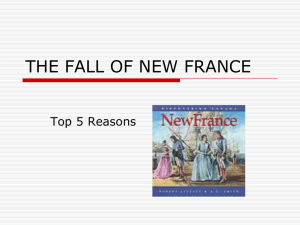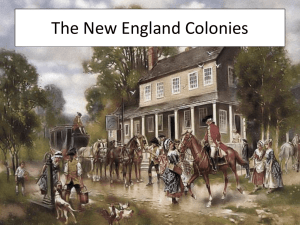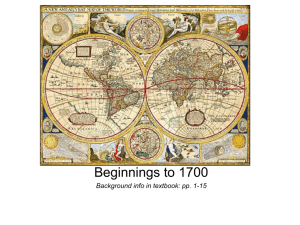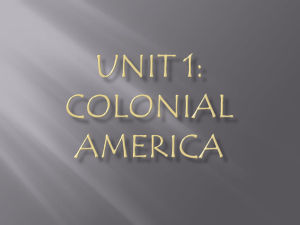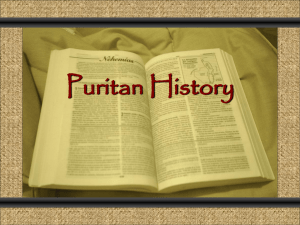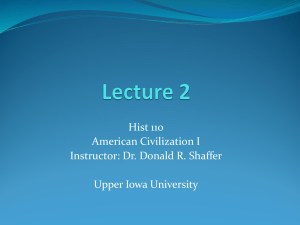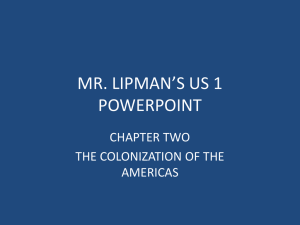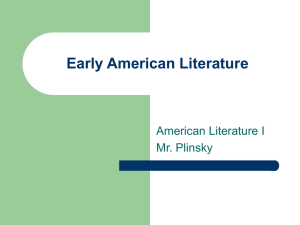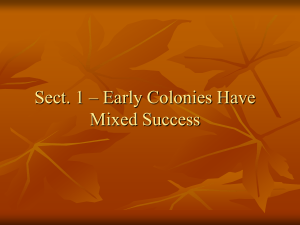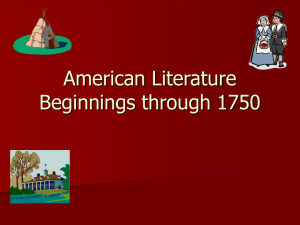Puritans Create a “New England”
advertisement
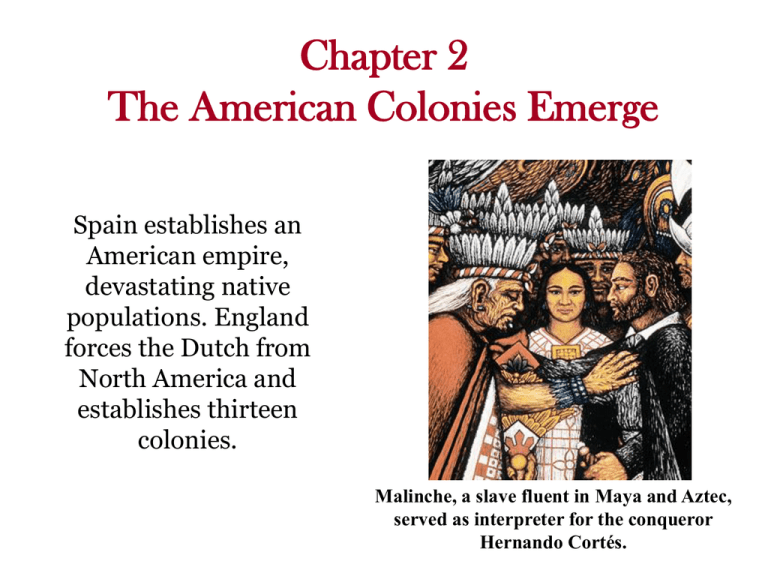
Chapter 2 The American Colonies Emerge Spain establishes an American empire, devastating native populations. England forces the Dutch from North America and establishes thirteen colonies. Malinche, a slave fluent in Maya and Aztec, served as interpreter for the conqueror Hernando Cortés. The Spanish Conquest Section 1 Spain’s Empire in the Americas Throughout the 1500s and 1600s, the Spanish conquer Central and portions of North America 1492 Columbus claims San Salvador for Spain SECTION 1 The Spanish Claim a New Empire Cortés Subdues the Aztec • Conquistadors (conquerors)—Spanish explorers, looking for gold, silver • 1519 Hernándo Cortés led an army into Americas (Mexico); claimed land for Spain • Aztec dominated region; Nahua (people who resented the Aztec) joined Cortés • Montezuma thought Cortés was a god; gave him a share of Aztec gold • In 1520 Aztec rebelled; in 1521 Spanish and their allies defeated Aztec • Cortés founded Mexico City, New Spain colony on Tenochtitlán ruins SECTION 1 The Spanish Claim a New Empire Spanish Pattern of Conquest • Spanish settlers mostly men, called peninsulares; marry native women • Mestizo—person of mixed Spanish and Native American ancestry • Landlords use encomienda—force natives to farm, ranch, mine • Priests object, encomienda abolished; Africans brought as slaves SECTION 1 The Conquistadors Push North Other Countries Explore North America • England, France, Netherlands sponsor voyages in 1500s and 1600s Exploring Florida • Juan Ponce de León discovers and names La Florida (1513) • Pedro Menéndez de Avilés expels French, founds St. Augustine (1565) Settling the Southwest • In 1540, Francisco Vásquez de Coronado leads expedition to Southwest • Pedro de Peralta, governor of New Mexico, Spain’s northern holdings • He helps found Santa Fe (1609–1610); several missions built in area San Luis Rey mission (about 1900). SECTION 1 Resistance to the Spanish Conflict in New Mexico • Priests convert many Native Americans, try to suppress their culture • In 1670s Spanish force natives to pay tribute, do labor for missions Popé’s Rebellion • Pueblo religious leader Popé heads uprising in New Mexico (1680) • Pueblo destroy Spanish churches, execute priests, force Spanish out • Spanish armies regain area 14 years later Section 2 An English Settlement at Jamestown The first permanent English settlement in North America is founded at Jamestown, Virginia, in 1607 SECTION 2 English Settlers Struggle in North America The Business of Colonization • Joint-stock companies—investors fund colony, get profits • The first attempt at a colony failed (Roanoke, 1585-1587) • In 1607, Virginia Company sent 150 people to establish Jamestown A Disastrous Start • Colonists seek gold, suffered from disease and hunger • John Smith forced colonists to farm; got help from Powhatan people • (1609) 600 colonists arrived; Powhatan destroyed farms; “starving time” SECTION 2 SECTION 2 English Settlers Struggle in North America Jamestown Begins to Flourish • New arrivals revived and expanded colony; grew tobacco “Brown Gold” and Indentured Servants • Tobacco became profitable; Virginia exported 1.5 million pounds by late 1620s • Headright system—purchaser of passage got 50 acres—lured settlers • Plantation owners used indentured servants- worked 4 to 7 years for passage SECTION 2 SECTION 2 English Settlers Struggle in North America The First African Laborers • First Africans arrived, 1619; treated as indentured servants • Late 1600s, owners began importing costly slaves because - indentured population decreased - colony became wealthy SECTION 2 The Settlers Clash with Native Americans The English Pattern of Conquest • English do not live or intermarry with Native Americans The Settlers Battle Native Americans • Continued hostilities between Powhatan and English after starving time • 1614 marriage of Pocahontas and John Rolfe created temporary peace • Renewed fighting; king made Virginia royal colony under his control Powhatan Uprising 1622 SECTION 2 SECTION 2 Economic Differences Split Virginia Hostilities Develop • Former indentured people settle frontier, cannot vote, pay high taxes • Frontier settlers battle natives; tension between frontier, wealthy • Governor refuses to give money to help frontier fight local natives Bacon’s Rebellion • Nathaniel Bacon raises army to fight natives on frontier (1676) • Governor calls Bacon’s army illegal; Bacon sets fire to Jamestown Letter Assignment • Pretend you are a colonist in Jamestown. Write home to your family about what you have experienced thus far in the New World. • Responses should be at least a half page! Section 3 Puritan New England English Puritans come to North America beginning in 1620 SECTION 3 Puritans Create a “New England” CAUSES Puritans want to leave because of: Religious persecution Puritans and Pilgrims • Puritans, religious group, want to purify Church of England Bad economy Political repression Puritan • Separatists, including Pilgrims, form independent congregations • In 1620, Pilgrims flee to escape persecution, found Plymouth Colony Migration Puritans: EFFECTS Establish Puritan Church Puritan work ethic Native American Problems SECTION 3 Puritans Create a “New England” Plymouth Plantation • 1620: Mayflower and the first pilgrims • Originally were headed for the Chesapeake (Virginia), but got blown off course • Not legally where they were supposed to be, but formed their own government, and stayed •Mayflower Compact: first CIVIL GOVERNMENT in the New World SECTION 3 Puritans Create a “New England” The Massachusetts Bay Company • In 1630, joint-stock company founds Massachusetts Bay Colony • John Winthrop is Puritan colony’s first governor “We shall be as a city on a hill. The eyes of all people are upon us.” -John Winthrop SECTION 3 Puritans Create a “New England” “City Upon a Hill” • Puritan adult males vote for General Court; Court chooses governor Church and State • Civic officials are church members, have duty to do God’s will Importance of the Family • Puritans generally migrate as families • Community makes sure family members behave in “God-fearing” way SECTION 3 Dissent in the Puritan Community The Founding of Providence • Roger Williams: extreme Separatist minister with controversial views • General Court ordered his arrest; Williams fled • In 1636 he founded the colony of Providence - negotiated for land with Narragansett tribe - guaranteed separation of church and state, religious freedom Anne Hutchinson Banished • Anne Hutchinson taught church, ministers were unnecessary • Hutchinson banished 1638; family, followers left colony SECTION 3 Native Americans Resist Colonial Expansion Disputes Over Land • Settlers spread to western Massachusetts, New Hampshire, Connecticut • Natives think land treaties temporary, Europeans think permanent SECTION 3 Native Americans Resist Colonial Expansion The Pequot War • Pequot War: Pequot took stand against colonists; nearly destroyed SECTION 3 Native Americans Resist Colonial Expansion King Philip’s War • Deprived of land, natives toil for English, must follow Puritan laws • Wampanoag chief Metacom organizes tribes to wipe out settlers (1675) • King Philip’s War fierce; hunger, disease, casualties defeat tribes SECTION 3 Section 4 Settlement of the Middle Colonies The Dutch settle New Netherland; English Quakers led by William Penn settle Pennsylvania. SECTION 4 The Dutch Found New Netherland A Diverse Colony • • • • In 1621, the Dutch West India Company colonized New Netherland Settlers from other European countries and Africa welcomed Dutch traded for furs with Native Americans Bought Manhattan Island from the Natives English Takeover • In 1664, duke of York becomes proprietor (owner) of New Netherland - renames colony New York - later gives part of land to friends, names it New Jersey SECTION 4 The Quakers Settle Pennsylvania Penn’s “Holy Experiment” • In 1681, William Penn founds Pennsylvania on Quaker principles • Quakers ideas: equality, cooperation, religious toleration, pacifism • Pennsylvania meant to be a “holy experiment” - adult males get 50 acres, right to vote - representative assembly - freedom of religion Native American Relations • Penn treats native people fairly; over 50 years without conflict William Penn and Native Americans SECTION 4 The Quakers Settle Pennsylvania A Thriving Colony • Penn recruits immigrants; thousands of Germans go to Pennsylvania • Quakers become minority; slavery is introduced Thirteen Colonies • Lord Baltimore, a Catholic, founds Maryland; has religious freedom • James Ogelthorpe founds Georgia as haven for debtors • By 1752, there are 13 British colonies in North America Journal Entry • First, read pp. 40-47 (stop at Bacon’s Rebellion). Next, answer the following questions: 1.What difficulties did the English settlers at Jamestown face? 2.How did the growing of tobacco affect the Jamestown colony? 3.How did the headright system work? 4.How did indentured servitude compare to African Slavery? Poetry Analysis • Read the poem “To the Virginian Voyage.” • Annotate this poem by circling words you do not understand, underline important information, and put a star next to lines that go against what you know to be true about the Jamestown colony. • On the back of this poem, make a chart. What were the realities of Jamestown, and what is made up (idealized) in the poem about the colony? Truth Fiction (what did the author lie about?) Create a Timeline • First read pp. 47-48 • Create a chronological timeline that shows the events of Bacon’s Rebellion. Be detailed and give dates of events. • On the back of your timeline, answer the following question: – What were the causes and consequences of Bacon’s Rebellion? Be prepared to discuss with the whole class! Colonial Advertisement • Pretend you are the founder of one of the following American Colonies: Mass. Bay Colony, Pennsylvania, Rhode Island, Maryland, or Georgia. • You want to recruit people from England to your colony. To do this, create a colorful flyer that describes why your colony is the best of the 13. Focus on this question: Why would people want to move there?? • Use color, draw pictures, and use persuasive headlines/text. Gather information from Sections 2 and 3 of this chapter. Pequot War Video Compare and Contrast • Compare and contrast New Netherland and Pennsylvania using a Venn diagram.

